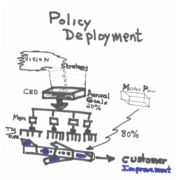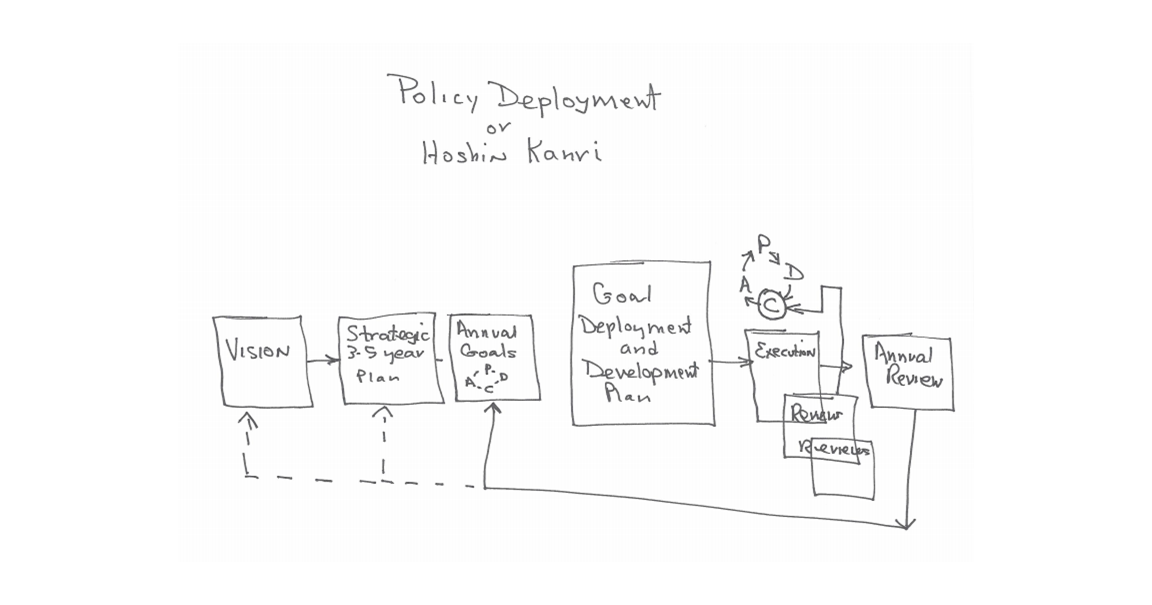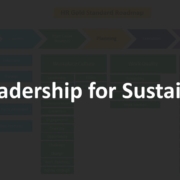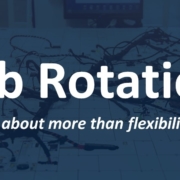The Role of HR in a Continuous Improvement Organization: Policy Deployment
(Reposted by permission of the author from LinkedIn)
Policy Deployment is a process to align and gain commitment from all the employees of the organization to accomplish business objectives. It is designed to improve the organization using 20% of the annual effort during the annual planning period. The other 80% of the total effort is focused on achieving the Master Plan to satisfy customer demand. It creates the order, priority and activities to accomplish the organization’s annual objectives. These objectives are the first year of the strategic plan. It is driven by an in-depth analysis of the organization, its internal and external environment, and those issues that drive competitiveness. Its function is to create a smooth and aligned environment with the people inside the organization while putting their competition at a competitive disadvantage.
Policy Deployment accomplishes organizational alignment through an explicit methodology:
- Establishes commitment for the key goals that support the strategy
- Sets the targets that accumulate to accomplish the goals
- Gains commitment from those who are required to see the tasks through.
Alignment is accomplished through a series of steps at every level of the organization that assures the goals are accomplished by using good critical thinking to define the problems fully and reduce them to a plan that defines how they will be accomplished.
The methods for gaining commitment are set up so that the person(s) who writes the plans are responsible for their accomplishment. This establishes accountability. These plans are set up for development growth through proper analysis, done by the leaders delegating the goals to be accomplished.
Policy deployment is an important process for developing each individual and the company through the process of stretching them a little beyond what they believe is possible. The tasks are set up to develop the employee’s skills as they are currently assessed. The goals and the planning associated become the route to higher competency through solving problems and accomplishing planned tasks. The timing of each task is set and expected. They are reviewed formally quarterly and informally each day by their supervisor with the aim of providing help for the problems
Prior to the execution of the policy deployment process, developmental assessments and discussions with each employee are conducted by their supervisor to determine what the developmental issues are and how they are going to be developed. The supervisor prepares for the meeting by accumulating critical incidents to share with the employees as indications of behaviors to be developed. The employee also conducts their assessment of themselves by rating their attainment of competency. Both the employee and supervisor review the critical instances and the employee’s self-rating to determine the priority of developmental needs. The goals are then set to define how the employee will gain development. These decisions are then utilized to determine what the employee must do to both develop and support their supervisor in the accomplishment of the organizational goals. These are components of a disciplined process aimed at both development and accountability of each individual.
The conversations held between the supervisor and their direct reports are a development dialog aimed at improving the performance of both the company and the individual. It starts with an informal conversation with all the direct reports and is based around, “here is what I am thinking about my goals, what do you think?” The conversation is put in place to get the subordinates started thinking about their goals and to get their commitment for what the supervisor is thinking are his/ her goals. The supervisor’s goals may change but the beginning of the analysis and thinking by the subordinates is a vital link between them. This conversation may happen on several occasions.
The intent of the process is to allow the subordinate to create their plan so that commitment becomes easier. However, the supervisor, who is analyzing the critical incidents of the subordinates, may have a different ideal of what they want from each individual. Remember, there are three goals:
- To support the organizational goals
- To develop the subordinate
- Setting the individual goals separately to accommodate all their different developmental needs.
The supervisor must navigate through their language to achieve consensus. Consensus occurs because the subordinates are willing to support the supervisor. This creates a better sense of teamwork, harmony and mutual trust and respect.
This process of deployment differs from the Master Schedule of operations due to the priority of satisfying the customer. Developmental goals are planned separately to ensure time is allocated. It is the leader’s responsibility to ensure the individual’s goals are seen separate but just as important as the Master Schedule. This is a message that both are important to the long-term viability of the organization.
Policy deployment also sets the support for the individual’s goals by identifying who is required to support the goals and what is expected from them. The support organizations, in turn, must ensure their goals are not independent of the others in the organization and that time for support is included in their individual goal timing. This creates a network of individuals who both accomplish and support in the expectations of their roles in the organization. It is expected that the reviews conducted will include support functions.
It is important to understand that Policy Deployment serves many purposes including setting priority for change defined in each of the individual’s goals. It is a strategy of getting everyone engaged in the critical work of improvement of the organization. It sets expectations for the individuals that are supported throughout the organization. It develops individuals using the goals as the mechanism. It sets up individual accountability. It clearly defines the commitment of support for other’s goals as an extension of each individual’s own goals.
Why are evenness and harmony important in an organization who conducts policy deployment? We all have experienced the inefficient and ineffective use of time in setting goals that are only taken out of the desk at review time. Although they inflict anxiety when this is planned, as an HR professional you must be asking what good is goal setting if they are not used to guide behavior on a consistent basis. Wouldn’t it be more sensible for everyone to be clear and have a plan of their own to accomplish the goals knowing they are supported and everyone else is doing the same? Surely this harmony created by a universal understanding of what is important creates a sense of mission. Isn’t the message of development usually a hollow one if not backed by intent and action? Shouldn’t everyone get developed as a matter of leadership commitment? Using the policy deployment process with the intent of answering these questions will make sense to all and create the evenness of culture desired for flexibility when change is required.
The HR role follows the same pattern we have discussed. The final setting and agreement on goals is a product of a simple back and forth (catch ball) in a commitment to equal listening and responding. The goal setter feels heard and the goal deployer has a firm commitment to achieving the change desired. Coaching to ensure these discussions go well and the organizations are not sending out mixed messages; it is confirming to the subordinate that planning is not just for production but a stated and enacted priority. Development becomes a matter of strategy not just convenience. HR also teaches the skills needed for this significant conversation. HR ensures that the conversations are backed by actual observations, critical incidents, and not the “hot button” (considering the most recent behaviors the most important) at the time for deployment. HR also monitors the daily interactions between the supervisor and the subordinate to ensure mutual trust and respect.
Finally, we should understand how to construct policy deployment for success:
- Make the process simple and understood by all
- Ensure it is more about the quality of the conversation
- Monitor the alignment outcomes to the organization’s goals
- Ensure commitment for support is defined and agreed to
- Make sure good critical thinking goes into the end product. It is full of facts and not opinions. The logic supports the intent of initiatives, goals, targets
- The accountability of each individual must be clear
- The script used to conduct the process does not wander
- The deployment conversations are about support by the supervisor
- The reviews are aimed at finding and supporting the resolution of problems from a developmental standpoint
- It is supportive of the culture desired
Policy deployment may be a bit awkward at first but if processed as desired, it will be natural in a very short period of time.

 2019, Total Systems Development, Inc.
2019, Total Systems Development, Inc.
 2019, Total Systems Development, Inc.
2019, Total Systems Development, Inc. 2019, Total Systems Development, Inc.
2019, Total Systems Development, Inc.
 2019, Total Systems Development, Inc.
2019, Total Systems Development, Inc. 2019, Total Systems Development, Inc.
2019, Total Systems Development, Inc.
 2019, Total Systems Development, Inc.
2019, Total Systems Development, Inc. 2019, Total Systems Development, Inc.
2019, Total Systems Development, Inc.